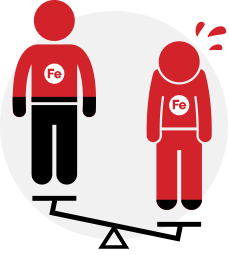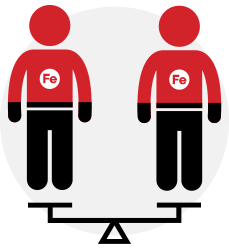
When you receive a simple transfusion, healthy donor cells are added to your existing iron-containing red blood cells, which can increase iron levels. During automated and manual exchange therapy, some of your iron-containing cells are removed, so even though you receive healthy donor cells, your iron levels can stay approximately the same.3,8,13,14

Chelation Therapy
This therapy is performed with an IV or oral medication when your iron levels are too high. The drug binds to the iron and other metals in your blood and is removed through your urine.Will I need chelation therapy?
It is hard to predict whether you will require iron chelation therapy. However, some studies show iron overload is more frequent for patients receiving simple transfusions compared with automated or manual exchanges.3,8,13,14Ask your doctor for more information.
1World Health Organization (WHO). Fifty-ninth world health assembly. Sickle-cell anaemia: report by the Secretariat. https://who.int. Published April 24, 2006. Accessed June 1, 2020.
2American Society of Hematology. Understanding the Impact of Sickle Cell Disease. https://www.hematology.org/education/patients/anemia/sickle-cell-disease. Accessed November 5, 2020.
3Danielson CF. The role of red blood cell exchange transfusion in the treatment and prevention of complications of sickle cell disease. Ther Apher. 2002;6(1):24-31.
4Centers for Disease Control and Prevention. Sickle Cell Disease. Data & Statistics on Sickle Cell Disease. https://www.cdc.gov/ncbddd/sicklecell/data.html#:~:text=SCD%20affects%20approximately%20100%2C000%20Americans,sickle%20cell%20trait%20(SCT). Accessed June 1, 2020.
5Tsitsikas DA, Sirigireddy B, Nzouakou R, et al. Safety, tolerability, and outcomes of regular automated red cell exchange transfusion in the management of sickle cell disease. J Clin Apher. 2016;31(6):545-550.
6Dedeken L, Le PQ, Rozen L, et al. Automated red blood cell exchange compared to manual exchange transfusion for children with sickle cell disease is cost-effective and reduces iron overload. Transfusion. 2018;58(6):1356-1362.
7Kuo K, Ward R, Kaya B, Howard J, Telfer P. A comparison of chronic manual and automated red blood cell exchange transfusion in sickle cell disease patients. Br J Haematol. 2015;170(3):425-428.
8National Institute for Health and Care Excellence (NICE). Spectra Optia for automatic red blood cell exchange in patients with sickle cell disease. https://www.nice.org.uk/guidance/mtg28/chapter/5-Cost-considerations. Accessed November 2020.
9Singer T, Quirolo K, Nishi K, Hackney-Stephens E, Evans C, Vichinsky E. Erythrocytapheresis for chronically transfused children with sickle cell disease: an effective method for maintaining a low HbS level and reducing iron overload. J Clin Apher. 1999;14(3):122-125.
10Duclos C, Merlin E, Paillard C, et al. Long-term red blood cell exchange in children with sickle cell disease: manual or automatic? Transfus Apher Sci. 2013;48(2):219-222.
11Howard J. The role of blood transfusion in sickle cell disease. ISBT Science Series. 2013;8:225-228.
12Barth D, Sanchez A, Thomsen A, et al. Peripheral vascular access for therapeutic plasma exchange: a practical approach to increased utilization and selecting the most appropriate vascular access. J Clin Apher. 2020;35(3):178-187.
13Adams DM, Schultz WH, Ware RE, Kinney TR. Erythrocytapheresis can reduce iron overload and prevent the need for chelation therapy in chronically transfused pediatric patients. J Pediatr Hematol Oncol. 1996;18(1):46-50.
14Fasano RM, Leong T, Kaushal M, Sagiv E, Luban NL, Meier ER. Effectiveness of red blood cell exchange, partial manual exchange, and simple transfusion concurrently with iron chelation therapy in reducing iron overload in chronically transfused sickle cell anemia patients. Transfusion. 2016;56(7):1707-1715.
15Al-Salem AH. Medical and Surgical Complications of Sickle Cell Anemia. Springer; 2016.
16Cobianchi C, Fafoutis D, Roig J, Dierick K, Comasolivas N. Measuring health-related quality of life in individuals with sickle cell disease undergoing automated red blood cell exchange. Poster presented at: Sickle Cell Disease Association of America Annual Meeting: October 2018; Baltimore, MD.
17Barth D, Nemec RM, Cho DD, et al. The practical integration of a hybrid model of ultrasound-guided peripheral venous access in a large apheresis center. J Clin Apher. 2020; 35(4):328-334.
18Crookston KP. Therapeutic Apheresis: a Physician’s Handbook. 5th ed. Bethesda, MD: AABB/ASFA; 2017.
19AABB. Circular of Information for the Use of Human Blood and Blood Components. Bethesda, MD: AABB; 2017.
20European Directorate for the Quality of Medicines & HealthCare (EDQM). Guide to the Preparation, Use and Quality Assurance of Blood Components. 20th ed. Strasbourg, France: EDQM Council of Europe; 2020.